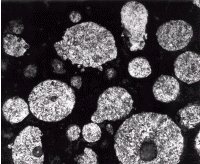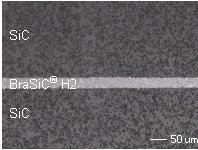|
Structural materials
Definition of structural materials with reduced activation
The viability of fusion as a future source of energy will be in part determined by factors linked to safety and the environment. Fusion has intrinsic advantages such as
the impossibility of runaway reaction and the absence of
long-life radioactive waste from fusion reactions. These arguments can be
further reinforced by appropriate management of activated materials. Fusion
benefits also from its relative early development, to include as early as possible in design, the solutions offered by the use of low activation structural materials . These materials have the advantage of offering a rapid drop in activation.
Note that a low activation material should be able to be handled without complex precautions after a period of 100 years. Besides low activation properties, the materials chosen should have thermo-mechanical properties appropriate for use as internal component structural materials.
The two main design processes of this type of materials consist of :
-
replacing in currently existing steels the elements that are penalising from the point of view of activation (nickel and molybdene for example) with more advantageous elements, but also compatible from a metallurgical point of view (manganese or tungsten for example). The main difficulty consists in defining an alloy that is not subject to the effects of expansion under
irradiation, nor deterioration in its thermo-mechanical properties. Excellent results are obtained on structures of rapid neutron reactor fuel assemblies. For the moment it mainly concerns enhancing composition to give preference to low activation ingredient elements while preserving qualities under
irradiation. This is the path of research favoured by the European Union, which is developing a low activation martensitic steel called EUROFER.
-
not using steels, but other families of materials, such as vanadium alloys or silicon carbide composites offering fast deactivation properties while at the same time holding certain advantages as regards thermal properties (refracting materials). The knowledge base on these materials is smaller
due to their relatively recent use. Europe is carrying out exploratory research on the subject.
Activities of the EURATOM-CEA Association
The Association actively participates in the European programme of development of low activation martensitic steel EUROFER, as well as in studies devoted to silicon carbide composites. We quote here some research subjects carried out by the Association :
- Metallurgical features and mechanical property definition of EUROFER.
- Development of manufacturing processes (powder metallurgy
etc.).
- Development of SiC-SiC assembly techniques.
|

Metallograpy of EUROFER
powder (x200)

SiC/SiC assembly
|
For further information :
- Fusion Technology. Annual Report of the Association
EURATOM/CEA
Material activites
|
 1998 issue,
47p, 1931 ko, PDF,
1998 issue,
47p, 1931 ko, PDF,

 1999
issue,
63p, 3286 ko , PDF, 1999
issue,
63p, 3286 ko , PDF,

 2000
issue: 107p, 9275 ko, PDF, 2000
issue: 107p, 9275 ko, PDF,

 2001
issue: 107p, 10562 ko, PDF, 2001
issue: 107p, 10562 ko, PDF,

 2002
issue: 117p, 14312 ko, PDF,
2002
issue: 117p, 14312 ko, PDF,

 2003
issue: 91p, 8104 ko, PDF,
2003
issue: 91p, 8104 ko, PDF,

 2004 issue (PDF)
2004 issue (PDF)
- pages 000-014 :
Cover,
contents, introduction (518 Ko)
- pages 135-170 : EFDA
activities: structural materials (2 871 ko)
- pages 283-290 : Underlying
technologies: structural materials (2 020 ko)
 2005 issue (PDF)
2005 issue (PDF)
- pages 000-004 :
Cover,
contents, introduction (824 Ko)
- pages 221-262 :
EFDA
activities: structural materials (3 402 ko)
- pages 371-380 :
Underlying
technologies: structural materials (2 020 ko)
 2006 issue (PDF)
2006 issue (PDF)
- pages 000-004 :
Cover,
contents, introduction (1.4 Mo)
- pages 212-253 :
EFDA
activities: structural materials (4.1Mo)
- pages 254-257 :
EFDA
activities: IFMIF (0.5 Mo)
- pages 362-366 :
Underlying
technologies: structural materials (0.2 M
|
.
|
|